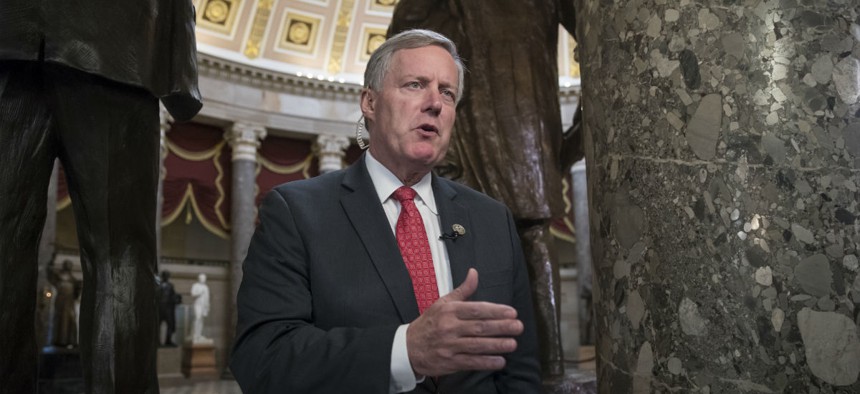
Rep. Mark Meadows, R-N.C., said, “We don't know how many guidance documents agencies have issued, nor do we know how much it will cost the economy.” J.Scott Applewhite/AP
GOP Lawmakers Fault Agencies for Issuing Too Much Guidance
House Republicans are targeting the informal documents agencies publish to explain complex rules.
House Republicans on Wednesday continued their effort to curb what they see as regulatory overreach, targeting the informal and non-binding “guidance” documents agencies publish to explain complex rules.
The hearing of the House Oversight and Government Reform Committee also highlighted Government Accountability Office findings that many agencies are derelict in giving Congress adequate time to review new regulations.
Democrats and some witnesses defended the need for resource-strapped agencies to issue supplementary guidance to help businesses and other stakeholders operate safely and with certainty about their obligations.
“In 2016 alone, 18 regulations were issued for each law passed by Congress,” said Government Operations Subcommittee chair Rep. Mark Meadows, R-N.C. “Unfortunately, we don't know how many guidance documents agencies have issued, nor do we know how much it will cost the economy.”
In response to the committee’s oversight project begun in December, Meadows announced, agencies provided information on more than 12,800 guidance documents. But only 189, or less than 0.015 percent, were submitted to Congress and the GAO as required by the 1996 Congressional Review Act, Meadows said. “The heart of the issue” he said, is the effect and legal status of this guidance that “doesn’t constitute a rule or regulation.”
According to the GAO counsel, guidance, which can come in the form of memos or FAQ’s, is not legally binding. The possible exception is tax guidance from the Internal Revenue Service, which tax professionals consider “authoritative.” Rep. Jim Jordan, R-Ohio, said he plans to challenge that reading, noting that the tax agency, under a memorandum of understanding, does not submit its regulations for approval by the Office of Management and Budget.
However, Rep. Carolyn Maloney, D-N.Y., noted the American Institute of Certified Public Accountants told the IRS that specific areas “need immediate guidance in order for taxpayers and practitioners to comply with their 2017 tax obligations and to make informed decisions regarding cash-flow, entity structure, retirement, wealth transfer and a vast number of other tax planning issues.”
Maloney said that she and other Democrats believe “rules and guidance documents should be fair, open, and informed by those entities and individuals who are regulated by them. However, we cannot simply eliminate them. That would result in chaos.”
Maloney criticized the Trump Health and Human Services Department for canceling an Obama-era rule assuring access to Planned Parenthood services without public rulemaking or comment, at the behest of a single activist, she said.
“Guidance works best if there is ongoing interaction between regulators and the regulated entities,” she said, citing conversations with stakeholders, advisory committee meetings and town halls. “But we need to avoid placing an overwhelming burden on federal agencies. Guidance documents are effective precisely because regulators can issue them more quickly than formal rulemakings.”
Recent GAO studies have shown that agencies during presidential transitions rush out large numbers of so-called “midnight regulations,” testified Kris Nguyen, GAO’s acting director of strategic issues. A study of the Clinton, Bush, and Obama administrations found they published on average roughly 2.5 times more economically significant regulations during presidential transition periods (Sept. 23-Jan. 20) than during other times.
Though the agencies generally complied with OMB's procedures, they need to do better at notifying Congress to comply with the Congressional Review Act, she said. “The most common deficiency is failure to provide Congress enough time to review under CRA.”
The most prolific agencies are the Health and Human Services Department, the Environmental Protection Agency and the Agriculture Department. Overall, more than 25 percent of economically significant regulations were issued without complying with the Congressional Review Act, she said, one reason being that many agencies don’t see all rules as significant.
Many agencies “did not have written procedures for the production of guidance, and about half did not regularly evaluate whether issued guidance was effective and up-to-date,” she added.
Two representatives from business applauded the Trump-era rollback of “burdensome” regulations, though they acknowledged that guidance can be useful to regulated parties. “To be sure, guidance can play a beneficial role, but no one knows how many and where to find them all” absent a centralized place on agency websites, said Paul Noe, vice president of public policy at the American Forest and Paper Association.
Karen Harned, director of a legal center at the National Federation Independent Business, applauded Attorney General Jeff Sessions’ move last November to cut off guidance that “purports” to change laws.
But Nicholas Parrillo, a Yale University Law professor, who conducted 135 interviews with regulatory experts for the Administrative Conference of the United States, said, “It was clear from these interviews that guidance increases an agency program’s integrity and efficiency and shields regulated parties against unequal treatment, unnecessary work, and unnecessary risk.”
“It’s okay to issue guidance as long as it’s not cut and dried, but flexible,” he added.
Amit Narang, the regulatory policy Advocate for the liberal-leaning Public Citizen—which is suing the administration over the constitutionality of Trump’s 2-for-1 executive order to reduce rules—highlighted the health and safety benefits of regulations. The Trump agencies, he said, “think that transparency is not needed if they’re deregulating.”
NEXT STORY: Play of the Day: Farewell, Rex







